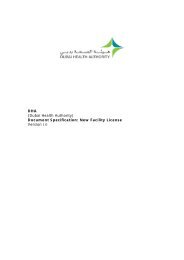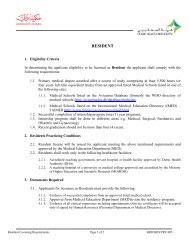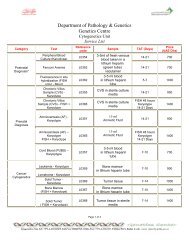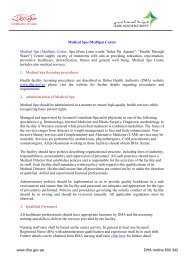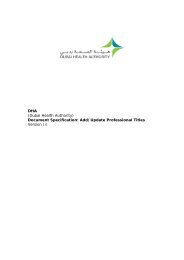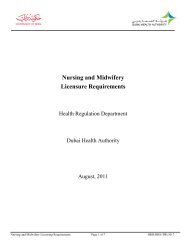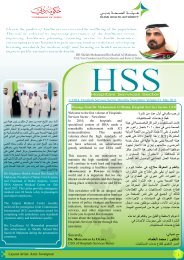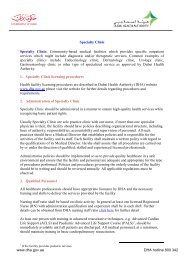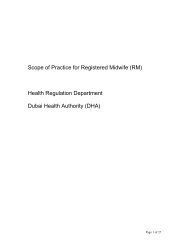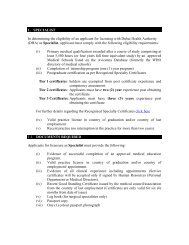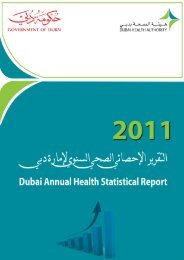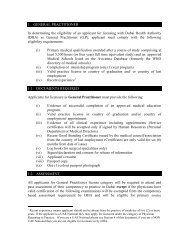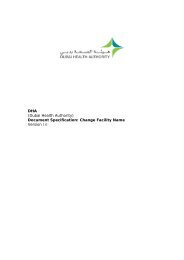Diabetes Mellitus among School Age Children in Dubai
Diabetes Mellitus among School Age Children in Dubai
Diabetes Mellitus among School Age Children in Dubai
You also want an ePaper? Increase the reach of your titles
YUMPU automatically turns print PDFs into web optimized ePapers that Google loves.
Published by: Statistical Analysis SectionIssue: 6Apr - Jun 2006The Departmentof Health andMedical Servicesstrives to become aprom<strong>in</strong>ent health <strong>in</strong>stitution car<strong>in</strong>gfor the human be<strong>in</strong>g throughout thelife. As statistics is needed as aunify<strong>in</strong>g voice for DOHMS activitiesand advocacy, The Sixth Issue ofStatistical News (April - June 2006)reflects the role of DOHMS <strong>in</strong>collect<strong>in</strong>g and analyz<strong>in</strong>g data fromall health sectors <strong>in</strong> <strong>Dubai</strong>. Itfeatures diabetes mellitus <strong>among</strong>school age children <strong>in</strong> <strong>Dubai</strong> andmalignant neoplasm’s of breast <strong>in</strong>DOHMS.From theHope the newsletter provesbeneficial with regards to yourprofession. Your comments arewelcomed.Diiabetes Melllliitus <strong>among</strong> <strong>School</strong>l <strong>Age</strong>Chiilldren i<strong>in</strong> <strong>Dubai</strong>i<strong>Diabetes</strong> is one of the most common Non -communicable disease <strong>in</strong> children andadolescents. When diabetes strikes dur<strong>in</strong>g childhood, it is rout<strong>in</strong>ely assumed to be type 1, orjuvenile-onset diabetes. However, the end of the 20th century witnessed a dramatic rise <strong>in</strong> the<strong>in</strong>cidence of type 2 diabetes <strong>in</strong> children. Although considered uncommon a few decades ago,type 2 diabetes <strong>in</strong> adolescents now represents one of the most rapidly grow<strong>in</strong>g forms ofdiabetes worldwide .Not surpris<strong>in</strong>gly, the <strong>in</strong>cidence of type 2 diabetes <strong>in</strong> adolescents hasparalleled the epidemic of childhood obesity now occurr<strong>in</strong>g <strong>in</strong> Westernized societies. It isbelieved that the genetic and lifestyle factors that <strong>in</strong>crease the risk of develop<strong>in</strong>g type 2diabetes <strong>in</strong> adolescents and adults are similar. <strong>Children</strong> and adolescents diagnosed with type 2diabetes are generally between 10 and 19 years old, obese, have a strong family history fortype 2 diabetes, and have <strong>in</strong>sul<strong>in</strong> resistance. Generally, children and adolescents with type 2diabetes have poor glycemic control. It is hard to detect type 2 diabetes <strong>in</strong> children because itcan go undiagnosed for a long time; children may have no symptoms or mild symptoms; andbecause blood tests are needed for diagnosis. It is difficult to be sure it is type 2, becausecriteria for differentiat<strong>in</strong>g between types of diabetes <strong>in</strong> children are confus<strong>in</strong>g; that is, childrenwith type 2 can develop ketoacidosis; children with type 1 can be overweight; and because theoverall prevalence of the disease may still be low (1) . <strong>Diabetes</strong> mellitus is a significant causeof morbidity and mortality <strong>in</strong> UAE. Deaths attributed to DM accounted for 2.1-3.1% of alldeaths <strong>in</strong> the last ten years (2) .Inside this issue:<strong>Diabetes</strong> <strong>Mellitus</strong> <strong>among</strong> <strong>School</strong> <strong>Age</strong><strong>Children</strong> <strong>in</strong> <strong>Dubai</strong>Malignant Neoplasms of Breast <strong>in</strong>female, <strong>Dubai</strong>Statistical Analysis SectionPlann<strong>in</strong>g & Statistics DepartmentDepartment of Health & Medical Services<strong>Dubai</strong> - United Arab EmiratesThere was 304 persons withdiabetes mellitus <strong>among</strong> theschool age group (4-19 years)diagnosed by specialist cl<strong>in</strong>ics<strong>in</strong> DOHMS <strong>in</strong> 2005, 229(75.3%) Emirates and 24.7%Expatriates. Among Emiratechildren, females amounted to46.7% of the cases, (Figure1). Type1 diabetes mellitusconstituted 91.2% of Emiratesdiabetic cases, (Figure 2).Study<strong>in</strong>g the distribution bylevel of education, thepercentage <strong>in</strong> k<strong>in</strong>dergartenwas 7.4%, 41.0% were<strong>among</strong> primary, 21.0% <strong>among</strong>preparatory and 70 cases(30.6%) were <strong>among</strong>secondary school children.Study<strong>in</strong>g the distribution oftype1 diabetes mellitus byage, there was a peak at 11years old.Figure (1) Distribution of Emirate Diabetic CasesDiagnosed <strong>in</strong> Specialist Cl<strong>in</strong>ics <strong>in</strong> DOHMS by Sex ,<strong>Dubai</strong> 200547%MalesFemales53%Figure (2) Distribution of Emirate Diabetic CasesDiagnosed <strong>in</strong> Specialist Cl<strong>in</strong>ics <strong>in</strong> DOHMS byType ,<strong>Dubai</strong> 20059%91%Type 1Type2Issue 6Statistical News1
In <strong>Dubai</strong>, <strong>Diabetes</strong> mellitus amounted for 1.9 % of all admissions<strong>in</strong> DOHMS <strong>in</strong> 2005. It constituted 2.6% of all admitted cases <strong>in</strong>the school age group 4-19 years <strong>in</strong> DOHMS <strong>in</strong> 2005. There were18 cases, 86 (72.9%) Emirates and 27.1% expatriates. Study<strong>in</strong>gthe distribution of diabetes mellitus <strong>among</strong> Emirates, there were51 (59.3%) males and 35 (40.7%) females. Type 1 diabetesamounted to 93.02% of the cases. Study<strong>in</strong>g the distribution oftype 1, diabetes by age, there is a peak at 11-12 years. As forcomplications of type 1 diabetes, keloacidosis constituted 38.8%;other complications 16.2% and 45% of the diabetic childrenwere not complicated, (Figure 3). The distribution was nearly thesame <strong>in</strong> both males and females, but ketoacidosis was more <strong>in</strong>males (41.3%).Figure (3) Distribution of Type 1 <strong>Diabetes</strong> <strong>Mellitus</strong>Complications <strong>among</strong> <strong>School</strong> <strong>Age</strong> <strong>Children</strong> <strong>in</strong> DOHMS,<strong>Dubai</strong> 200545%16%There were 597 diabetic persons below 25 years reported by theprivate health sector <strong>in</strong> <strong>Dubai</strong> <strong>in</strong> 2005, 55.9% were males and44.1% females. Only 27 cases (4.5%) were below 15 years.Type 1 diabetes amounted to 43.6% of the cases and Type 2diabetes 56.4%. Emirates amounted to 14.1% of the cases.Comments and Recommendation:39%Ketoacidosis Other & Multiple Complications No ComplicationType 2 diabetes mellitus is a new morbidity <strong>in</strong> children andadolescents. For pediatric patients, it heralds earlier onset ofcardiovascular disease, ret<strong>in</strong>opathy, nephropathy, andneuropathy, with risk of impaired quality of life and prematuredeath. The emergence of type 2 diabetes mellitus <strong>in</strong> youngpeople is believed to be associated with changes <strong>in</strong> physicalactivity and nutrition that are ubiquitous <strong>in</strong> modern society (3) .Prevention must take highest priority and should focus ondecreas<strong>in</strong>g the risk, <strong>in</strong>cidence, and consequences of type 2diabetes mellitus <strong>among</strong> children. Primary prevention efforts byprimary health care professionals are recommended <strong>in</strong> twoarenas: general community health promotion and healtheducation and cl<strong>in</strong>ically based activities. Cl<strong>in</strong>ically based healthpromotion activities should not duplicate community-wide healthpromotion but <strong>in</strong>stead should offer additive benefits. Thepr<strong>in</strong>ciples of manag<strong>in</strong>g children with type 2 diabetes <strong>in</strong>cludediabetes self-management education, nutrition management,exercise prescription, pharmacological management andpsychosocial considerations (4.5.6) .As <strong>in</strong> adults with type 2 diabetes, adolescents may be able toeffectively manage this condition with lifestyle adjustmentsfocused on choice and amount of foods <strong>in</strong>gested comb<strong>in</strong>ed with<strong>in</strong>creased physical activity. One major therapeutic goal shouldbe ma<strong>in</strong>tenance of a desirable body weight. As <strong>in</strong> adults, m<strong>in</strong>orreductions <strong>in</strong> weight can have dramatic results on glucosetolerance. This underscores the value of frequent access to adiabetes team that can assess, prescribe, and assist <strong>in</strong> theimplementation of these children's care plans. Smok<strong>in</strong>gcessation is essential s<strong>in</strong>ce tobacco use magnifies the risk forlong-term micro- and macro vascular complications andaggravates co-morbid problems (e.g., hypertension) (6.7) .Adolescence is well known to be characterized by dim<strong>in</strong>ishedadherence to medical regimens and <strong>in</strong>creases <strong>in</strong> risk-tak<strong>in</strong>gbehaviors. This problem is compounded by the focus on shorttermrather than long-term goals typical of many adolescents.Parents may be reluctant to comply with <strong>in</strong>sul<strong>in</strong> therapy. Propereducation of the family is essential to maximiz<strong>in</strong>g adherence tothe medical regimen (4.6) .Most overweight children with type 2 diabetes have dim<strong>in</strong>ishedexercise tolerance. A contribut<strong>in</strong>g factor is the lack of physicaleducation <strong>in</strong> schools. Gett<strong>in</strong>g adolescents to engage <strong>in</strong> physicalactivity takes an understand<strong>in</strong>g of what each child considers"acceptable." An overly ambitious exercise prescription can result<strong>in</strong> poor adherence and frustrate teens and their families (4.8) .For most <strong>in</strong>active teens, walk<strong>in</strong>g is a good start. If there is anactivity a child enjoys, such as team sport, this can also be used.Exercise must be started slowly (3 times a week) and for shortperiods of time (15–20 m<strong>in</strong>utes) to build tolerance. The goal isto develop a healthy pattern of regular physical activity, not acompetitive athlete. Parents or other family members should beencouraged to participate. This will help the entire family adopta healthier lifestyle and improve adherence <strong>in</strong> most cases. Thekey to a successful exercise program for children, as for adults,is to engage <strong>in</strong> an enjoyable activity. As children develop greaterexercise tolerance, encourage <strong>in</strong>creas<strong>in</strong>g the duration and<strong>in</strong>tensity of their physician activity (8) .Nutritional education is a cornerstone of therapy for childrenwith type 2 diabetes. Often, these children come from a homeenvironment with a poor understand<strong>in</strong>g of healthy eat<strong>in</strong>g habits.Adolescents and their families must be encouraged toconsistently make better food choices. This beg<strong>in</strong>s by teach<strong>in</strong>gparents what foods to br<strong>in</strong>g home and how to plan meals andsnacks (9) .Recommendation:1. More elaborate data and precise <strong>in</strong>dicators are required toassess the magnitude of the problem of diabetes mellitus <strong>in</strong><strong>Dubai</strong> <strong>in</strong> preparation for the development of a plan for theprevention and management of the disease <strong>in</strong> <strong>Dubai</strong>.2. A Task Force Group should be developed from DOHMS andM<strong>in</strong>istry of Education for study<strong>in</strong>g the nature of diabetesmellitus <strong>among</strong> school children <strong>in</strong> <strong>Dubai</strong> and develop<strong>in</strong>g aprogram for manag<strong>in</strong>g and controll<strong>in</strong>g the disease. TheDepartment of Plann<strong>in</strong>g and Statistics should be engaged <strong>in</strong>that activity. A proposed protocol for study<strong>in</strong>g diabetesmellitus <strong>among</strong> school children <strong>in</strong> <strong>Dubai</strong> was prepared bythe Department.3. The Research and <strong>Diabetes</strong> committees <strong>in</strong> DOHMS and <strong>in</strong>collaboration of the Department of Plann<strong>in</strong>g & Statistics andDepartment of Primary Health Care should design andimplant a study for study<strong>in</strong>g diabetes mellitus <strong>among</strong>Emirate Population 18 years and above <strong>in</strong> <strong>Dubai</strong>. Asuggested protocol is prepared by the Department.References:1. Epidemiology of type1 and type2 diabetes mellitus <strong>among</strong> North American children &adolescents available from CDC (home page on the <strong>in</strong>ternet).http://www.cdc.gov/diabetes/projects/cda2.htm2. Annual report 2004. Preventive Medic<strong>in</strong>e Section, M<strong>in</strong>istry of Health - U.A.E.3. Internal diabetes federal (homepage on the <strong>in</strong>ternet) type2 diabetes <strong>in</strong> the young,available form http://www.eatlas.idf.org/Prevalence/Type_2_<strong>in</strong>_the_young4. Guidel<strong>in</strong>es for school health programs to promote life long healthy eat<strong>in</strong>g MMWR June 14,1996 145 (RR-9), 34-41. available form.5. Medic<strong>in</strong>e net com. (obesity double kid’s diabetes risk), available formhttp://www.medic<strong>in</strong>enet.com/script/ma<strong>in</strong>/art.asp?articlekey=577276. Risk reduction for type 2 diabetes <strong>in</strong> Aborig<strong>in</strong>al children <strong>in</strong> Canada, Pediatrics & ChildHealth 2005; 10(1): 49-52, available fromhttp://www.cps.ca/English/statements/II/FNIH05-01.htm7. Obesity Doubles Kids' <strong>Diabetes</strong> Risk Available fromhttp://www.medic<strong>in</strong>enet.com/script/ma<strong>in</strong>/art.asp?articlekey=57728. <strong>Diabetes</strong> Spectrum. Type2 <strong>Diabetes</strong> <strong>Mellitus</strong> <strong>in</strong> Teens Volume 13 Number2, 2000, Page95,available http://journal.diabetes.org/diabetesspectrum/00v13n2/pg95.htm9. Simple Steps to Prevent<strong>in</strong>g <strong>Diabetes</strong> Available fromhttp://journal.diabetes.org/diabetesspectrum/00v13n2/pg95.htmIssue 6 Statistical News2
Malliignantt Neeopllassm’’ss off Brreeasstt i<strong>in</strong>DOHMS, , <strong>Dubai</strong>iWith one million new cases <strong>in</strong> the world each year, breastcancer is the commonest malignancy <strong>in</strong> women and comprises18% of all female cancers and is the s<strong>in</strong>gle commonest cause ofdeath <strong>among</strong> women aged 40-50, account<strong>in</strong>g for about a fifth ofall deaths <strong>in</strong> this age group. For so many women, there is nomore dreaded disease than breast cancer. Breast cancer elicitsfears related to loss of body image and sexuality, surgery, anddeath. As is the case for most cancers, the exact cause of breastcancer is not clearly known. Furthermore, there is currently nocure for advanced disease, and there is no def<strong>in</strong>itive way ofprevent<strong>in</strong>g it (1) .The <strong>in</strong>cidence of breast cancer <strong>in</strong>creases with age, doubl<strong>in</strong>gabout every 10 years until the menopause, when the rate of<strong>in</strong>crease slows dramatically. In some countries there is aflatten<strong>in</strong>g of the age-<strong>in</strong>cidence curve after the menopause. The<strong>in</strong>cidence of breast cancer is greater <strong>in</strong> women of higher socioeconomicbackground. The relationship of breast cancer riskwith socio-economic factors is most likely related to the lifestyle, differences like age at first childbirth and number ofpregnancies (1.2) .Data of the national cancer registry <strong>in</strong> UAE shows that cancerbreast was the most common cancer (27.2%) of all cancers<strong>among</strong> females and accounted for 9.3% of all deaths <strong>among</strong>females <strong>in</strong> 2003 (3) . Cancer is the second lead<strong>in</strong>g cause of deathis <strong>Dubai</strong> (14.8%) follow<strong>in</strong>g cardiovascular diseases thataccounted for 22.8 % of all deaths (4) . Information of malignantneoplasm’s of Breast (C50) diagnosed <strong>in</strong> DOHMS hospitals wascollected from the electronic network of health <strong>in</strong>formationsystem <strong>in</strong> DOHMS. Retrospective case series of cancerdischarged dur<strong>in</strong>g the period 2004- 2005 were reviewed. Basicdata were age, sex, nationality, diagnosis and outcome atdischarge.There were 254 malignant neoplasms of breast (249 femalesand 5 males) admitted <strong>in</strong> DOHMS <strong>in</strong> 2004-2005. Breast cancerwas the most prevalent neoplasm (34.5%) <strong>in</strong> females. Emiratesamounted for 30.1% of cases and Expatriates 69.9.8%, (Table1). The mean age of the studied cases was 47.86 ± 13.33 years.It was 49.2 ± 15.30 for Emirates and 47.28 ± 12.99 forExpatriates. This difference is not significant. As for the age ofdistribution, 14.9% was below 35 years, 29.7% were 35-44years, 28.1% of cases were <strong>in</strong> the age group 45-54 years and27.3% were 55 years and above, (Table 1 & Figure 1). Theaverage length of stay <strong>in</strong> hospital was 3.37± 6.63 days. It was5.34 ± 10.02 for Emirate females and 2.43 ± 3.8 forexpatriates. This difference is significant (P = 0.001). The casefatality rate was 9.2%. It was 13.33% <strong>among</strong> Emirate femalesand 7.47% <strong>among</strong> Expatriates. This difference is not significant.Table (1) Summary characteristics of MalignantNeoplasm’s of Breast <strong>among</strong> Inpatients <strong>in</strong> DOHMS,<strong>Dubai</strong> 2004-2005VariableValue% Among Female Cancer 34.5Nationality (%)Emirates 30.1Expatriates 69.9<strong>Age</strong> (%)



